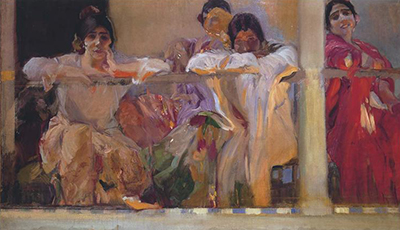 Buy Art Prints Now
Buy Art Prints Nowfrom Amazon
* As an Amazon Associate, and partner with Google Adsense and Ezoic, I earn from qualifying purchases.
This multiple portrait painting was created in 1915, as far as we can tell, but little other information is available about it. Artist's Patio, Cafe Novedades, Seville features a number of young women relaxing in the shade besides a small cafe.
Women and children would feature many times within Sorolla's career and he tended to prefer capturing them within informal, natural settings rather than asking them to pose in the more traditional style of portraiture. These formal, straight on works would more likely be specially comissioned artworks in which he was not given the full artistic license that he normally preferred. The work found here, therefore, shows Sorolla doing what he loved most, and that was focusing on the lives of ordinary people going about their leisure time around the various regions of Spain. Women, he felt, always brought a greater level of charm and beauty to his paintings, also normally offering more of an aesthetic interest with complex clothing, jewellery and so on. He would use his own wife to model for him many times, sometimes as herself, sometimes in playing a part to suit a particular idea of his.
The detail in this painting is not refined in the same way that Sorolla would normally do elsewhere - it suggests that he worked more quickly here and also that he was allowing his expressive nature to take over, rather than merely attempting to produce a photo-realistic copy of what was before him at the time. As art moved deeper into the 20th century there would be a much greater use of emotion within art, and a shift away from some of the academic rigidity that had given us the likes of Bouguereau in previous generations. This would herald an exciting new era, and Sorolla himself would sit somewhere in the middle of this, as an artist who loved and respected the old masters, but also wanted to see brighter palettes and more flexibility within contemporary art.
Sorolla would have been inspired by the achievements of French artists around a decade or two earlier and so taken on some of their ideas. That said, he certainly incorporated many of his own ideas that were specific to his geographical roots, meaning he was proudly promoting the beauty of Spain whilst encouraging a more modern style of art. Originally he had at times been darker in tone but this changed as he became bolder and more ambitious, slowly moving away from the influence of the masters that he had studied in his early career. Today he is rightly regarded as one of the most important Spanish artists in history and his legacy, boosted by the museum in Madrid, is entirely secured.



